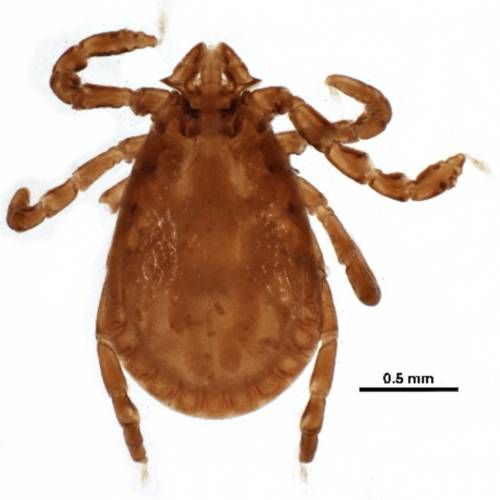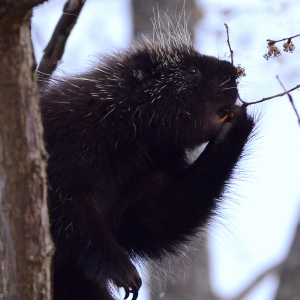UMass researchers discover rare rabbit ticks in Maine that carry new strain of bacteria

University of Massachusetts researchers have uncovered rabbit ticks in Maine that harbor a new strain of bacteria related to pathogens known to cause spotted fever in humans. CBG Photography Group/Wikimedia Commons
|
Published: 05-06-2025 12:09 PM
Modified: 05-09-2025 7:55 PM |
AMHERST — University of Massachusetts researchers have uncovered rabbit ticks in Maine that harbor a new strain of bacteria related to pathogens known to cause spotted fever in humans.
The discovery of rickettsia sp. ME2023 raises questions about the human impact of the bacteria strain, as well as the role that rabbit ticks play in maintaining and transmitting the bacteria. Rabbit ticks rarely bite humans, and even then bacteria transfer is highly unlikely if promptly removed.
“It’s as if we were taking a net into a pond and just sort of dipped in the net and we caught something,” said Stephen Rich, a microbiologist and investigator of Project ITCH, referring to the discovery made in a residential backyard.
“The work of figuring out the underlying biology, like how frequent it is in rabbits, do all rabbits get infected and just infect a small number of the ticks, do most ticks get infected and only infect a small number of rabbits — all those questions are much deeper and require a more focused effort,” Rich said.
Finding this type of rickettsia was an surprise result of Project ITCH, an initiative of the UMass-based New England Center of Excellence in Vector-borne Diseases (NEWVEC) that investigates best practices for tick control in residential backyard.
Researchers survey properties with varying levels of tick control, from professional treatments to complete neglect.
Ticks are collected from backyards and tested for a litany of common tick-borne illnesses such as anaplasmosis and Lyme disease, but the researchers run some open-ended tests for unusual or unknown pathogens.
“We just keep it on our radar,” said Rich, who serves as the executive director of NEWVEC. “In this instance, the ‘keeping it on our radar’ approach paid off because we found that these rabbit ticks had something that looks very similar to Rocky Mountain spotted fever or reasonably similar.”
Article continues after...
Yesterday's Most Read Articles
 Keeping Score with Chip Ainsworth: UMass hockey girds for new campaign
Keeping Score with Chip Ainsworth: UMass hockey girds for new campaign
 My Turn: A rocky road ahead for Stone Farm Lane proposal
My Turn: A rocky road ahead for Stone Farm Lane proposal
 ‘There’s always people you know here’: Bernardston’s Scarecrow in the Park brings community together
‘There’s always people you know here’: Bernardston’s Scarecrow in the Park brings community together
 Speaking of Nature: A surprise in my maple tree: Porcupines just want to find something tasty to eat and be left alone
Speaking of Nature: A surprise in my maple tree: Porcupines just want to find something tasty to eat and be left alone
 Greg Franceschi: Support bike lanes and walking paths in South Deerfield
Greg Franceschi: Support bike lanes and walking paths in South Deerfield
 Lowest bid comes in at less than $6M for Deerfield’s 1888 Building project
Lowest bid comes in at less than $6M for Deerfield’s 1888 Building project
Curious about the identity of the bacteria, Project ITCH researchers conducted DNA sequencing tests on the new bacteria and learned it didn’t exactly match any of the ricksettsia strains in the database.
The Centers for Disease Control and Prevention, which partners with and helps fund the NEWVEC, recognized the recently published paper and thinks the new rickettsia strain should be its own species, Rich said.
“This was a success story of how Project ITCH served this secondary role,” he continued. “We didn’t have that expectation that we were going to find this thing. That was serendipitous.”
While spotted fever rickettsioses, particularly Rocky Mountain spotted fever, can be deadly for humans, Rich clarifies that the role rabbit ticks play in spreading this pathogen in humans and other animals remains unclear.
Rabbit ticks mainly feed on wild rabbits, so they are rarely seen by humans, let alone bit by them.
However, indirect infection is theoretically possible and requires further study, Rich said. If a rabbit tick fed on a rabbit, exposing it to rickettsia, and a human-biting tick picked up the bacteria after feeding on the same rabbit, it might be transferred to a human.
“Ticks are biological entities and so not all ticks can support all bacteria,” Rich said. “It may be that deer ticks feed on rabbits all the time and they just do not provide a suitable environment for this ricksettsia to grow.”
A study completed by Project ITCH researchers, most notably lead author Guang Xu, indicate that rabbit ticks carrying pathogenic rickettsia may be a more widespread phenomenon.
When scientists tested samples of 296 ticks collected across 38 Maine towns, 6.1% of them tested positive for rickettsia sp. ME2023. A year prior, evidence of a genetically similar bacteria called candidatus rickettsia lanei, found in California, was also found in rabbit ticks.
“It didn’t surreptitiously end up in rabbit ticks in California and Maine,” Rich said. “It’s probably that these two things, rabbit ticks and rickettsia, have been associated for a long time in the evolution and we’re just starting to get a glimpse of it.”






 South County Notebook: Aug 17, 2025
South County Notebook: Aug 17, 2025 Mohawk Trail students to see new staff, new codes of conduct upon Aug. 27 return to school
Mohawk Trail students to see new staff, new codes of conduct upon Aug. 27 return to school Grand opening of Buckland-Shelburne Elementary School playground set for Aug. 26
Grand opening of Buckland-Shelburne Elementary School playground set for Aug. 26 Bear-y unwelcome: Why MassWildlife says it’s time to ‘break up’ with bird feeders
Bear-y unwelcome: Why MassWildlife says it’s time to ‘break up’ with bird feeders
